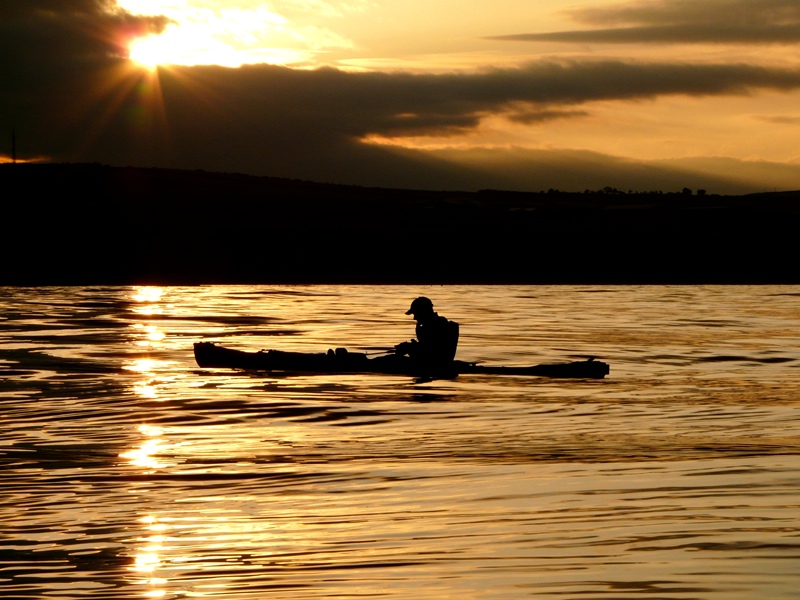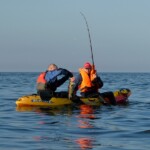With essential kit trialled, safety drills ingrained, and a few hours of basic handling in the can, Neil Turnbull now turns his attention to gearing up for fishing from a kayak.
With practise successfully undertaken, and having made yourself familiar with your kayak’s characteristics and limitations, the time comes to take your first proper fishing trip. The preparatory routine stays the same: check all your equipment is complete, and contact the Coast Guard before you launch. You can either phone them or call on your VHF using channel 16. If you are going to use your mobile phone, make sure you have all the local CG stations on your contacts list before leaving home. You will be asked a few details about your trip; this is where your paddle plan document comes in very handy. All the required information will be recorded there, including your CG66 identification number. This number alone provides all your shore contact details, your description, and your kayak’s colour etc.


All of these procedures may sound excessive, but after a few outings it will become routine. Compliance only takes a couple of minutes and the effort might one day be the difference between a successful rescue or being becoming another unfortunate maritime accident statistic. After a few ‘feeler’ trips you should have gathered a good bit of basic knowledge, your experience and confidence will quickly build on these foundations.
This first-hand basic grounding is important so you can make critical launch decisions. Is it too rough? Is it too windy? Will it get rougher when the tide turns against the wind?
With attention to detail and a few good paddle miles in the bank, you should be able to answer all these questions and call the right decisions on your own. It’s also important at this time to realise your own limitations. Safety is always your first consideration. Don’t be over ambitious. The rule is: If there’s any doubt, then don’t go out.
Core yak tackle
With your kayaking equipment, clothing and safety gear all soundly sorted we can now touch a little on fishing tackle. The choices in tackle are largely dependant on the venue and your target species. Most equipment suited to dinghy angling will fit the bill for kayak fishing. Because this is being read on an Internet fishing magazine, I am assuming that most of you will have at least a basic grasp of fishing methods. It’s really the kayak element that some might find a little alien. As a pointer, here are some kayak-specific tackle decisions to think about.

Rods
Make sure the rod is long enough to reach round the bow of the kayak to play a fish. There are quite a few out there that are too short. Avoid the latest push of 2-5 foot rods being marketing as kayak fishing rods. Unfortunately most of these are no more than glorified children’s toys, and wholly inappropriate for the nominated task. Unlike on a dinghy, you can’t walk a fish round the stern to play it from the other side of the boat. With this in mind, my personal rod choice would be a standard boat rod with minimum length of six foot.

As you are sitting down while fishing, the length of the handle between the reel seat should be carefully considered. Too long a handle tends to foul your PFD and will perhaps rattle your beer belly too. Look for a rod with as short a handle section as possible. If you cannot identify anything suitable then it is possible to cut a small piece off without affecting the performance of the blank. Don’t take too much off though, I’ve made this mistake before and rendered the rod useless.
Reels
Fixed spool reels are fine and are commonly used. The only issue here is if you use a kayak with a high side and a low seating position. Winding in without painfully rapping your knuckles on the gunwale is a challenge to say the least. Holding the rod in an elevated position to avoid this can become tiresome after a while. I find multipliers are a better bet and more suited to the task in hand. A good tried and tested multiplier winch for the rough stuff, and a smaller lighter one with brakes for trolling and casting. You will find that your reels regularly take a bath, so don’t buy any crappy Hong Kong e-bay specials, they won’t last a month in this harsh environment. Go for a brand name with a proven pedigree.

Line
Understand that 40lb braided line straight through would be impossible to break if you become snagged. You could probably use that sort of breaking strain for anchor warp! I tend to use 25lb braid and just a 3ft length of 20lb mono to act as a shock absorber before the trace. Trace body strengths vary depending on whether you’re making your own or buying them.
For rough ground fishing, I incorporate a weak link on the trace to prevent heavy tackle losses. More importantly it will prevent you from being hauled clean out of the kayak if you do get snagged!
Simplicity reigns
Follow the old ‘Keep it simple’ mantra with your terminal tackle. With limited space onboard you’ll soon learn that the kitchen sink can’t go with you. Sit down before you go out and work out a game plan for the day ahead. It is possible to have all your traces and rigs pre tied and in order ready to use. Waterproof “clip it” boxes are ideal for storing your traces and terminal tackle in. Rig wallets with zipped compartments will last no time and won‘t keep your gear dry.
Try and also limit your weights to the minimum, obviously take some spares but don’t go mad. Keep as much of your kit as close to hand as possible. Don’t store anything in the front hatch that you might need out at sea. Unless your boat has sealed bulk heads, keep the compartment hatches closed until you are safely on dry land. If you take a wave and go over with the hatch open your once safe floating platform will soon become a semi submerged death trap, and you then have a very serious situation on your hands. At first you WILL take far too much kit… everyone does. But you’ll quickly identify items that you use and those you have no need of. Your kit will soon become honed to your needs and much more streamlined.

Fishing tactics also follow that of small boat angling. If possible, stick to drift fishing or trolling to start with. The safe deployment, operation and recovery of anchors is a minefield. If not performed correctly, anchoring your kayak can be very dangerous, even life threatening in the extreme. Do’s and don’ts of anchoring are something that we will look at in detail in a later feature.
Drogues are a much safer option to begin with. With little or no surface drag your kayak will drift at an alarming rate in all but the lightest of winds, way too fast to effectively keep your bait on the bottom. The drogue or drift chute, will correct this problem easily. Again, drogues will be covered later in the series. As kayak angling becomes more main stream and continues to grow in popularity, tackle companies will no doubt start to produce and promote a larger range of kayak-specific fishing tackle… not before time if you ask me.






